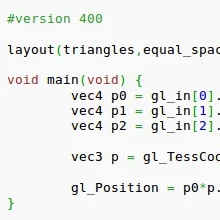Celebrating 20 Years Of OpenGL At SIGGRAPH 2012

For those not at SIGGRAPH LA 2012 (unfortunately I'm not there to provide any live coverage on Phoronix), here are some Internet resources:
- SIGGRAPH 2012 photos.
- The Khronos/OpenGL events listing.
- Twitter coverage.
- Other information from the SIGGRAPH web-site.
- I'm told there will be video recordings of some of the talks, but I have yet to see any publicly surface on the Internet.
Tonight is the OpenGL party to celebrate twenty years of OpenGL. It was in 1992 that SGI in collaboration with other companies released the OpenGL 1.0 specification, although today isn't the exact date. For historical sake, here's the original OpenGL 1.0 press release.
ARCHITECTURE REVIEW BOARD RELEASES OPENGL(TM) 1.0 SPECIFICATION;
EIGHT NEW OPENGL LICENSEES BRING TOTAL TO 21 INDUSTRY SUPPORTERS
MOUNTAIN VIEW, Calif., July 28 /PRNewswire/ -- Silicon Graphics Inc. (NYSE: SGI) and the OpenGL(TM) Architecture Review Board (ARB) today announced the official release of the OpenGL 1.0 Specification, Conformance Test and Sample Implementation. Silicon Graphics also announced eight new licensees of the OpenGL application programming interface (API), including Daikin Corp., Harris Computer Systems Division, Intergraph Corp., Kubota Pacific Computer, miro, NEC Corp., pellucid inc. and Sony Corp.
In addition, Concurrent Corp. plans to support the OpenGL API on its graphics products through a strategic partnership with Du Pont Pixel Systems. Ithaca Software also announced that its HOOPS(TM) API will support the OpenGL programming interface on multiple platforms. This brings the number of companies supporting the OpenGL API to 21, making it the most broadly supported 3D API in the computer industry.
The 21 companies that have announced their support for OpenGL to date will offer products across the seven largest UNIX(R) workstation platforms, as well as across major PC environments, including DOS and Microsoft Windows NT(TM).
"The release of OpenGL 1.0 to the computer industry heralds a new era for high performance 3D computing," said David Orton, general manager of Silicon Graphics' Advanced Graphics Division. "With the establishment of a high-performance, feature-rich open graphics standard for both PCs and workstations, the industry will see a tremendous increase in the number of software applications that incorporate 3D capabilities. The short time it took to formalize and release OpenGL to the industry is evidence of our commitment to making it a market-driven standard."
An evolution of Silicon Graphics' IRIS GL(TM), OpenGL is a rich, mature 3D graphics API that allows PC and workstation software developers to create applications for visualizing and manipulating color images. A rendering only API, OpenGL is vendor, operating system and windowing system independent. Licensees can implement the OpenGL programming interface as an extension to native windowing systems, such as the X Window System(TM), or Windows NT. Applications based on Silicon Graphics' GL(TM) are used by professionals in many fields, including architecture, product design, color publishing, medical imaging, animation, multimedia, scientific visualization and mechanical computer-aided design.
Add A Comment

